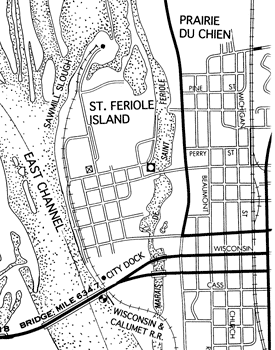Big
River Home ![]() Current
Highlights
Current
Highlights ![]() Big
River Marketplace
Big
River Marketplace ![]() Subscribe
Subscribe
From December
1997
December
1997
Moving a Neighborhood Out of Harm’s Way
Empty streets, sidewalks and shade trees are all that remain of the old neighborhood on St. Feriole Island.
by William J. Burke
The Flood of 1965 overtopped the 1997 and 1993 floods by about four feet in Prairie du Chien, Wisconsin. In April 1965, St. Feriole Island was completely flooded, as were homes and businesses along the mainland shoreline of the city east of the island. Over 1,100 people from a 17-block area — about a fifth of the city — were evacuated from 250 homes and 25 businesses.
Public utilities and transportation facilities were severely damaged, with about two million dollars in costs. A public meeting in January 1966 with the Army Corps of Engineers launched the search for a solution.This island was flooded several times between 1965 and 1975. The city adopted a flood plain ordinance in 1971 which regulated development in flood prone areas, including all of St. Feriole Island.Many people, weary of flood damage, wanted the Army Corps of Engineers to build dikes and flood walls to protect island residents and businesses. Instead the Corps began its first “non-structural” flood-control project. In other words, it removed the neighborhood from the island — a more permanent and far less expensive solution.The project was authorized by Congress in March 1974. The Flood Damage Reduction Project acquired 121 properties between February 1978 and September 1984.(At about this same time another nearby Wisconsin city, Soldiers Grove, initiated a non-structural solution to reduce flood damage from the Kickapoo River. This effort began in 1979 after a serious flood in 1978. Most of the downtown was simply rebuilt on higher ground.)
The City’s Birthplace
Prairie du Chien had its beginnings on this island. It was the first location of Fort Crawford, which was involved in the War of 1812, and is the home of the historic Villa Louis mansion, the origin of which goes back to Joseph “King” Rolette and Hercules Dousman, who made fortunes in fur trading and land dealings. The mansion already had some “natural” flood protection since it had been built on a large Indian mound.
Through the years a variety of industrial and commercial operations developed on the island. The four-story Dousman Hotel thrived in the heydays of the railroad and served a variety of other uses, including a stint as an Oscar Mayer packing plant in the 1930s and 1940s. The building is now classified as an historic structure and is being restored.Logging, trucking, barge terminal, sand pit, a radio station and clamming businesses also used the island at the time of relocation. Many are still there.
Strong Feelings
Empty streets, sidewalks and shade trees are all that remain of the old neighborhood on St. Feriole Island.
Despite the floods, many were not ready to move from the island. Ted and Marge Shecklern, lifetime residents of Prairie du Chien, speak admiringly about the “river rats” who lived on the Island.“It was sad to see these people moved off,” they agree.They provide moving testimony about the way life used to be on the island and the strong ties among those who lived there. Ted’s mom, Zella, was relocated. Ted says one important reason for the relocation was that the island was served by septic systems, which didn’t work well when flooded.Now that the area is mostly cleared, they would like to see it used for a four-unit ball field complex and other active recreational uses.Bill Howe, a long-time river conservationist and editor of the Prairie du Chien Courier-Press, covered much of this project for the newspaper. He believes it is a credit to the community that the city never had a closed meeting regarding the project. Howe points out that a common slogan for island residents at the time was, “We like it here.” He says that living on the island was more than possessing a home, “It was a way of life.”Once governmental officials initiated the project, the task of carrying out the relocation rested on the shoulders of Dale Klemme, who was employed by the city. Only one property had to be condemned, according to Klemme. He says that roughly half the residents opposed the relocation, and the other half went along with it.“There were emotional highs and lows for both the residents and myself,” Klemme recalled.Klemme believes that time is softening some of the hard feelings, but he understands the lingering emotions of families uprooted by this project. He thinks that the project has probably already paid for itself, considering the floods of 1993 and 1997.
The Future
In 1979, Mayor Fred Huebsch appointed a “Committee for the Re-Use of St. Feriole Island.” With the help of Madison’s Environmental Awareness Center, this committee and the citizens of Prairie du Chien produced a Re-Use Plan, which is part of the city’s Master Plan.
Current mayor, Karl Steiner, sees the island as a place for family-oriented activities, including an historical feature commemorating the last residents who called this island home. An annual rendezvous on the island commemorates its more distant heritage, from the early fur trading era.The traumatic and emotional effects on relocated residents and businesses should never be minimized or forgotten. These human impacts also become part of the heritage of a community. Perhaps this heritage will be commemorated by family reunions and festivals centered around those who lived on or had ancestors who lived on the island.The Mississippi Valley has probably not seen the last of such non-structural approaches to flood plain management. The imprint of almost 200 years of flood plain development is not easily undone. The Prairie du Chien project has helped lead the way to reinventing history and the environment along the Mississippi.
Copyright Open River Press